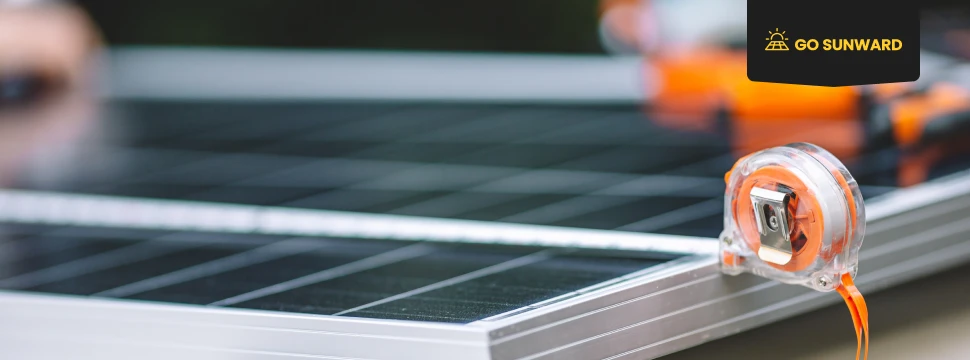What Types Of Solar Panels Are There? Know Before You Buy!
In the global effort to transition to clean and sustainable energy sources, solar panels have emerged as a pivotal player. These photovoltaic marvels harness the power of the sun’s rays and convert them into electricity. This offers a renewable and eco-friendly alternative to traditional energy sources. In the world of solar technology, a wide range of panel types exist, each with unique strengths and limitations. As a potential solar panel buyer, navigating this diverse landscape can be a tough task. Therefore, understanding what types of solar panels are available and which ones apply to your own needs is crucial.
In this article, we’ll look at the types of solar panels and shed light on their uses, advantages and disadvantages. We will also tackle common questions like how much panels cost and how long the installation takes. Meaning you’ll be well-equipped to make an informed decision to choose the right solar panel for your specific needs.
If you’re still learning the basics of solar, then read this guide first: What is a solar panel?
The Basics of Solar Panels
First things first, we need to cover the basics of solar power and how panels generate solar electricity.
Solar radiation, an electromagnetic radiation emitted by the sun, bathes the Earth in its radiant glow. Although every corner of our planet experiences sunlight year-round, the amount of solar radiation arriving at any given location varies. Innovative solar technologies harness and convert this radiation into practical forms of energy.
Solar power, being both renewable and environmentally friendly, faces limitations only in terms of our ability to maximize efficiency and cost-effectiveness in its conversion to electricity. Fortunately, two primary solar energy technologies efficiently translate solar energy into electrical power: photovoltaics (PV) and concentrating solar-thermal power (CSP).
The primary distinction between solar PV and solar CSP lies in their methods of converting solar energy into electricity. Solar PV systems directly convert sunlight into electricity through photovoltaic cells, while solar CSP systems concentrate sunlight to generate thermal energy used to produce electricity via steam-driven turbines.
In this article, we’ll focus on solar PV, as it’s used more commonly in residential solar systems in the US. You can even see how solar panels are made here.
Solar PV 101
Solar PV technology harnesses the photovoltaic effect, a phenomenon where photons, the basic units of light, strike the surface of a semiconductor material, such as silicon. This interaction imparts energy to electrons within the material, causing them to detach from their atomic bonds.
As these electrons, each bearing a negative charge, migrate toward the solar cell’s front surface, an electrical imbalance emerges between the cell’s front and rear surfaces. This discrepancy generates a voltage potential, akin to a battery’s positive and negative terminals. Electrical conductors on the cell capture these electrons. Electric current flows through the circuit when these conductors connect to an external load, such as a battery. This flow of electric current is recognized as direct current (DC), as electrons move in a continuous, unidirectional manner. This DC is then transformed into alternating current (AC) using inverters.
Solar PV technology finds common application in various settings, including rooftop installations, solar farms and arrays, as well as small scale setups. For more information on how solar electricity works, click here.
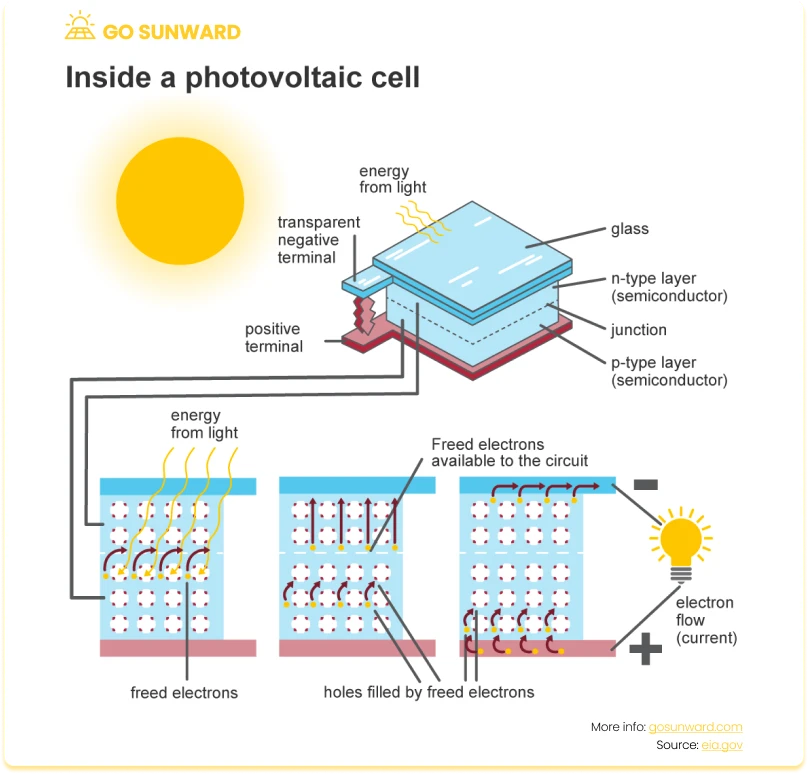
What Types Of Solar Panels Are There?
At present, photovoltaics is one of the most recognizable methods for capturing solar energy and mainly uses three technology panel types: Monocrystalline, Polycrystalline and Thin-Film Solar Panels. These options each bring with them distinct advantages and disadvantages. The choice of the most suitable solar panel type for your installation and which brands you choose depends on your preferences and the particular characteristics of your property.
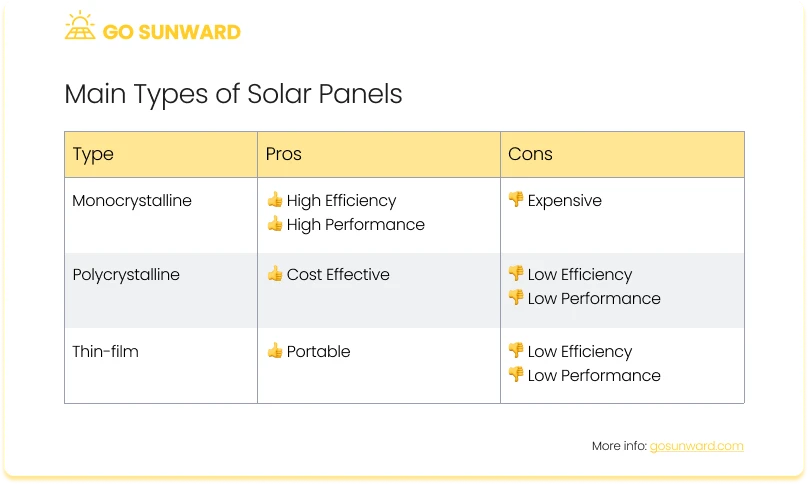
1. Monocrystalline Solar Panels
Monocrystalline solar panels are made from single-crystal silicon, producing an exceptionally efficient and uniform structure. The production process involves slicing cylindrical silicon ingots into thin wafers, which are the foundation for individual solar PV cells. Thanks to the high purity of monocrystalline silicon, these panels outperform other types in terms of converting sunlight into electricity.
Their distinctive dark black hue and rounded edges set monocrystalline solar panels apart. Their superior efficiency means they occupy less space to achieve the same power output, making them ideal for installations with limited rooftop or ground area. However, it’s worth noting that their higher manufacturing costs can result in slightly elevated prices.
2. Polycrystalline Solar Panels
Polycrystalline solar panels feature multiple crystal structures of silicon, giving them a distinctive bluish tint. The production process entails melting raw silicon and casting it into molds to form square shaped wafers. Polycrystalline panels are known for their cost effectiveness, as they are easier and more economical to manufacture compared to monocrystalline panels.
Although slightly less efficient than monocrystalline counterparts, ongoing technological advancements have narrowed the efficiency gap between the two types. Polycrystalline panels now offer good performance while remaining a popular choice for both residential and commercial installations due to their cost effectiveness and durability.
3. Thin-Film Solar Panels
Thin-film solar panels are made from thin layers of semiconductor materials, such as amorphous silicon, cadmium telluride, or copper indium gallium selenide (CIGS). This technology yields solar panels that are lightweight, flexible, and adaptable, capable of integration into various surfaces, including those with curves or irregular shapes.
While thin-film panels exhibit lower efficiency compared to monocrystalline and polycrystalline panels, they offer distinct advantages in specific cases They excel in low-light conditions and demonstrate resilience to high temperatures. Their ease of integration makes them well-suited for applications like building-integrated photovoltaics (BIPV), solar shingles, and other innovative solar designs.
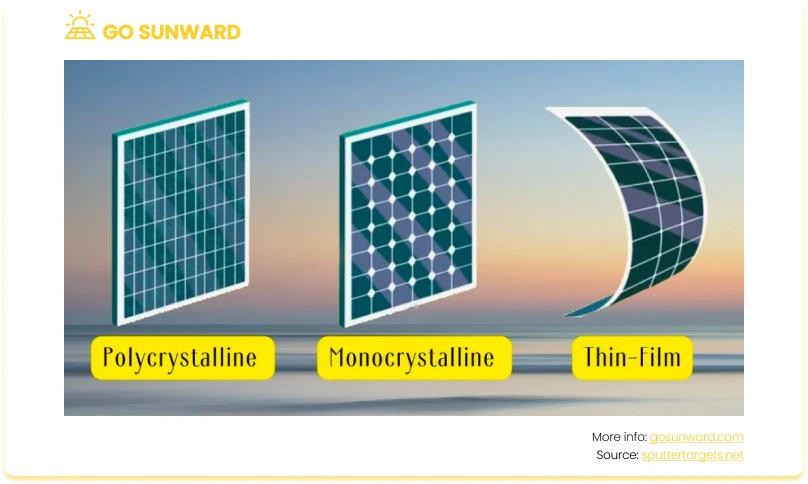
Others Panel Options To Consider
In addition to thin-film, polycrystalline, and monocrystalline solar panels, there are several other panel options to consider. Each of these options have their own unique characteristics and applications:
- Bifacial Solar Panels: Bifacial panels can capture sunlight from both the front and rear sides, making them more efficient by reflecting sunlight off surrounding surfaces. They are often used in installations where light can bounce off reflective surfaces, such as white roofs or snowy environments.
- Organic Photovoltaic (OPV) Solar Panels: These panels are made from organic materials and have the potential to be extremely lightweight and flexible. They are still in the experimental stage but hold promise for future applications.
- Building-Integrated Photovoltaics (BIPV): BIPV refers to solar panels that are built directly into building materials such as roofing, windows, or facades. This approach combines solar power generation with architectural design.
You should also consider how many of these solar panels you’ll need. See how many solar panels you need for 1000kWh per month.
Factors to Consider Before Buying
When you’re starting to use solar energy in your home, picking the right solar panel type is crucial. To make a smart choice, you need to think about a few important factors. First, check the efficiency of the solar panel type you’re looking at. Panels with higher efficiency generate more electricity from the same amount of sunlight, which is great if you have limited space. For more information on efficiency and how to calculate the number of panels you need, click here.
Additionally, evaluate the available space for solar panel installation. Different types of panels may have varying space needs, so matching the panel size to your available area is essential. Budget considerations also come into play, as the cost of solar panels can vary widely. Determine a budget that aligns with your financial goals and explore panels that offer the best balance between cost and efficiency.
Furthermore, consider your aesthetic preferences, especially if the panels will be visible on your property. Some types of solar panels may have a sleek, modern appearance, while others blend seamlessly with roofing materials. Ensuring that the chosen panel type complements your home’s aesthetics can be vital.
Also consider choosing your solar installer wisely, the best panels need the best care when doing the setup or you could waste a lot of money. The best solar companies offer guarantees, no matter how long your panels last.
How Long Will My Panels Last?
Both polycrystalline and monocrystalline solar panels are designed to last beyond 25 years. Although there’s debate over whether monocrystalline panels exhibit a slightly lower degradation rate, the specific type of silicon solar cell in your panels generally doesn’t significantly impact their overall durability.
It’s essential to grasp that solar panels function by converting sunlight into electricity, a process that gradually leads to a decrease in power output at a rate of about 0.8% per year. As a result, you can expect your panels to maintain about 99.2% of their original output in the second year, 98.4% in the third year, and so forth. This gradual decline in performance is a normal aspect of a solar panel’s lifespan.
Moreover, solar panel warranties provide valuable information about the expected longevity of your solar panels and related components, such as inverters. We recommend carefully reviewing these warranties as they can provide extra assurance regarding your solar energy system’s long-term performance.
How Long Will They Take To Install?
Installing enough solar panels to power a house is a methodical process that demands careful planning and execution. The timeline for installation hinges on the house size, electricity requirements, panel efficiency, and the intricacy of the installation.
The installation process typically includes several phases, such as site assessment, system design, permit acquisition, panel procurement, and the actual installation. The duration of each phase depends on factors such as local regulations and the availability of equipment and personnel. On average, the entire process may span from a few weeks to a few months.
And Finally, A Note Of Costs…
Setting up a solar panel system for residential electricity needs can represent a substantial upfront investment. However, the eventual advantages and savings can justify this endeavor. The total cost of installing a solar panel system fluctuates based on several factors, such as the system’s size, permitting requirements, hardware expenses, labor costs, financing options and of course the type of panel you go for: thin-film, polycrystalline or monocrystalline.
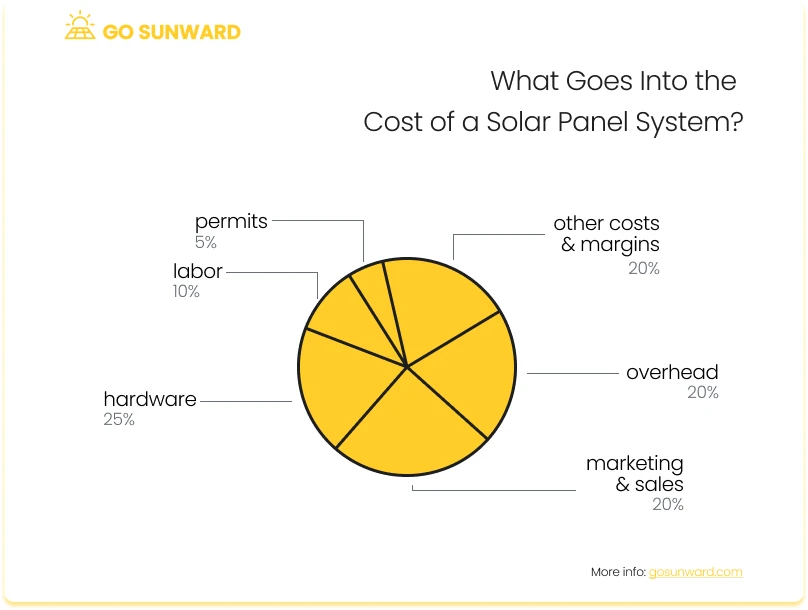
On average, in the United States, installing a typical residential solar system may fall between $15,000 and $25,000. This excludes any incentives and rebates. However, these costs can substantially decrease with available incentives and are subject to regional considerations and individual situations.
Conclusion
In the journey toward a more sustainable energy future, it’s crucial to understand the different types of solar panels available. In this article, we’ve explored various solar panel options, each with its own advantages and factors to consider. From the efficiency of monocrystalline panels to the cost-effectiveness of polycrystalline panels, the versatility of thin-film panels, and the innovation of bifacial and building-integrated panels, there’s a solar solution to suit every homeowner’s needs.
Your choice of solar panel type significantly impacts energy production and how well it meets your specific requirements. Factors like efficiency, available space, budget, and aesthetic preferences should all be carefully considered when you make this decision.
Take the time to explore your solar panel options, seek expert advice, and make a well-informed decision. When you choose the right solar panel type for your specific situation, you’re investing in a cleaner energy source and playing a part in creating a greener future for generations ahead. The power to transform your home and the planet is within reach; it’s time to put it to use.



